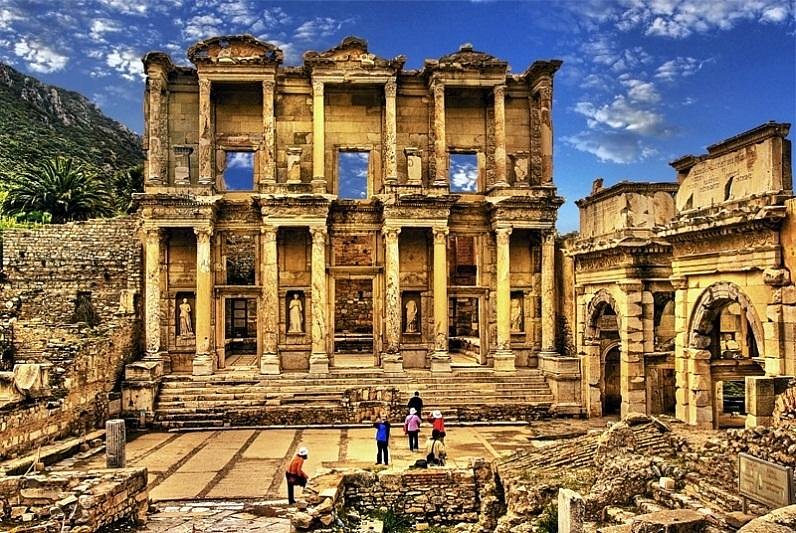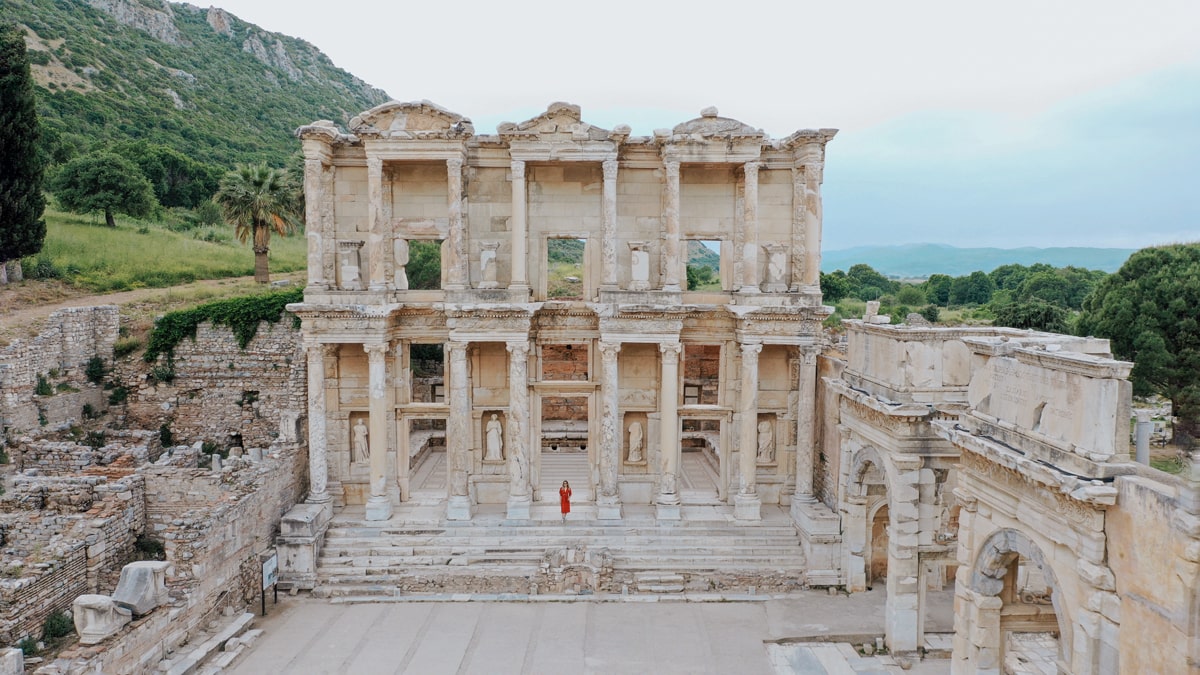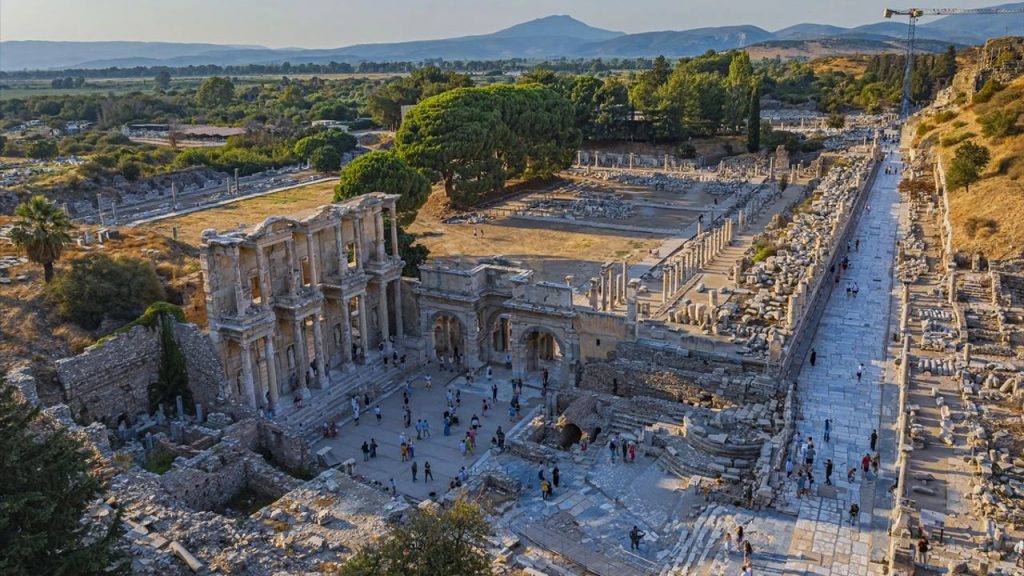Have you ever imagined walking in the footsteps of Roman senators on marble streets or sitting in a colossal theater where tens of thousands once cheered for a play? If your answer is yes, we invite you to Ephesus, one of the most magnificent metropolises of the ancient world and the capital of the Roman Empire's Province of Asia. This is not just a collection of stone and marble ruins; it was once a vibrant heart of commerce, culture, philosophy, and faith, with a population exceeding 200,000. In this article, we will explore the most impressive stops on the list of things to do in the Ancient City of Ephesus and uncover the secrets of this unique UNESCO World Heritage Site.
The story of Ephesus is not only a triumph of human hands but also a tale of a centuries-long struggle against the irresistible forces of nature. Once home to one of the busiest ports on the Aegean, the city was gradually pushed away from the sea by the silt carried by the Kaystros River (Little Menderes River), forcing it to relocate several times throughout its history. The ruins you will explore today represent the final and most glorious chapter of this epic struggle for existence. If you're ready, let's step into our time machine and get lost in the streets of this magnificent city!
Stand in Awe Before the Majestic Facade of the Library of Celsus
One of the first iconic structures to greet you as you step into Ephesus is undoubtedly the Library of Celsus. Its two-story facade, adorned with statues and intricate marble carvings, masterfully combines the elegance and power of Roman architecture. This building is not just an aesthetic masterpiece; it also holds a touching family story. The library was built in 117 AD by Gaius Julius Aquila in memory of his father, Tiberius Julius Celsus Polemaeanus, a Roman senator and the governor of Asia.
One of the most striking features of the library is that it served not only as a repository of knowledge but also as a mausoleum (heroon). Celsus's sarcophagus is located in a crypt beneath the main reading hall , a rare example in the ancient world of a library also serving as a tomb. The four female statues in the niches of the facade summarize the deep philosophy behind this monument: Sophia (Wisdom), Arete (Virtue), Ennoia (Judgment), and Episteme (Knowledge). These statues symbolize the virtues Celsus possessed, showing how his family wished him to be remembered: not for his power, but for his wisdom and character.
The architects used clever optical illusions to make the library appear larger and more imposing than it actually was. For instance, the podium is slightly convex, and the columns at the sides are shorter than those in the center. These details prove that Roman engineering was not just functional but also highly artistic. As you stand before this structure, which once housed over 12,000 papyrus scrolls , you'll feel that you are looking not just at a building, but at a monument dedicated to knowledge and an immortal legacy.

Sit on the Steps of the Largest Theater in the Ancient World
As you leave the elegance of the Celsus Library and proceed along Marble Street, a colossal structure suddenly appears before you: the Great Theatre of Ephesus. Nestled into the slope of Mount Pion, this structure holds the title of the largest open-air theater in the ancient world, with an incredible capacity of approximately 25,000 spectators. If you close your eyes and sit on one of the top steps, you can almost hear the sounds, applause, and cheers from thousands of years ago.
These steps witnessed not only the tragedies of Sophocles or the comedies of Aristophanes but also breathtaking gladiator fights, public assemblies, and events that changed the city's destiny. One of the theater's most dramatic moments occurred during the early years of Christianity. The sermons of St. Paul in Ephesus against the worship of pagan gods, especially Artemis, angered the artisans who made their living by crafting silver models of the Artemis temple, the backbone of the city's economy.
This economic threat quickly turned into a major riot, and an angry mob gathered in this theater. As described in the New Testament, thousands of people chanted Great is Artemis of the Ephesians! for hours, shaking the city. This event shows that the theater was not just a venue for entertainment but also a flashpoint for the city's social, religious, and economic tensions. Sitting on those steps and imagining the moments when one of civilization's greatest cultural transformations took place will give you goosebumps. Today, this structure with its magnificent acoustics occasionally hosts concerts by world-famous artists, continuing its mission of thousands of years.

Imagine the Roman Era While Walking on Marble Street
Walking on Marble Street, the city's main artery that stretches from the Great Theatre to the Celsus Library, is one of the most captivating moments of the Ephesus experience. The smooth marble slabs under your feet bear the marks of millions of footsteps, chariot wheels, and the weight of history. This street offers a unique opportunity to understand how organized, developed, and surprisingly similar to modern life an ancient city could be.
The colonnaded galleries (stoa) on both sides of the street served as covered sidewalks, protecting pedestrians from both the scorching sun and the rain. Behind these galleries were the city's busiest shops. Weavers, potters, food vendors... they all conducted their trade here, in the heart of the city. The advanced sewage system running beneath the street is a concrete proof of Roman urban planning and the importance they placed on public health.
However, what makes Marble Street truly special is a small but significant detail. On the ground, a carving in the marble will catch your eye: a left footprint, a heart, a woman's head, and a money purse. Historians believe this to be one of the first advertisements in history. These symbols discreetly directed sailors and visitors from the port to the nearby brothel: If you take the path on the left, you can be with a woman who will steal your heart, for a price. This small detail shows that Ephesus was not just about temples and libraries; it reveals how trade, social life, and even taboo subjects were cleverly woven into the urban fabric. While walking this street, you can enrich your journey by learning about other (https://www.yerelrehber.com/en/city/izmir), just like Ephesus.

Your Ephesus Adventure Isn't Over Yet!
After spending a magical time among the magnificent structures of the Ancient City of Ephesus, don't think your adventure is over. In fact, it's just beginning! Ephesus and its surroundings are full of many more treasures waiting for you. Since you've come this far, you should definitely add these stops to your itinerary:
Şirince Village: Just a few kilometers from Ephesus, this old Greek village is famous for its stone houses, narrow streets, and delicious fruit wines. It will offer you a completely different experience with its historical texture and peaceful atmosphere.
House of the Virgin Mary: A sacred pilgrimage site for Christians, this small stone house is believed to be where the Virgin Mary spent her final years. Be sure to visit to feel the spiritual atmosphere amidst the greenery.
Temple of Artemis: Although only a few pieces remain of this massive temple, one of the Seven Wonders of the Ancient World, seeing that single column is enough to imagine the structure's former glory.
Basilica of St. John: The ruins of this monumental basilica, built on the hill where the tomb of St. John, believed to be Jesus's most beloved apostle, is located, reflect the power and faith of the Byzantine era.
To discover more about this magical region and plan your trip down to the last detail, you can check out our comprehensive Izmir travel guide.
Frequently Asked Questions (FAQ)
1. What is the best time to visit the Ancient City of Ephesus? The ideal times to visit Ephesus are in the spring (April-June) and autumn (September-October), when you can avoid the sweltering summer heat and winter rains. If you plan to visit in the summer, we recommend going early in the morning to avoid the crowds and high temperatures.
2. How long does it take to fully explore Ephesus? To comfortably tour the main archaeological site, you should set aside about 2-3 hours. However, if you want to include nearby important sites like the Terrace Houses, Ephesus Museum, House of the Virgin Mary, and the Basilica of St. John in your visit, it's best to plan for a full day (at least 4-5 hours).
3. What are the 2025 visiting hours and entrance fees for the Ancient City of Ephesus? The current 2025 visitor information for Ephesus and its surrounding attractions is summarized in the table below. Please note that fees and hours may change depending on the season, so it's a good idea to check official sources before your visit.
| Venue | Foreign Visitor Fee (2025) | Museum Pass Turkey Status | Visiting Hours (Summer/Winter/Night) |
|---|---|---|---|
| Ephesus Ruins (Main Site) | €40
| Valid | Summer: 08:00-21:00 / Winter: 08:30-18:00 / Night: 19:00-22:30 (Select Days) |
| Terrace Houses | €15
| Not Valid | 09:00 - 18:50 |
| Ephesus Museum | €10
| Valid | Summer: 08:00-21:00 / Winter: 08:30-18:00 |
| Basilica of St. John | €6
| Valid | 08:30 - 18:00 |
Bibliography
For more detailed academic information about Ephesus and the justification for its UNESCO World Heritage status, see: UNESCO World Heritage Centre, Ephesus. Accessed: July 24, 2024.


 English
English Türkçe
Türkçe